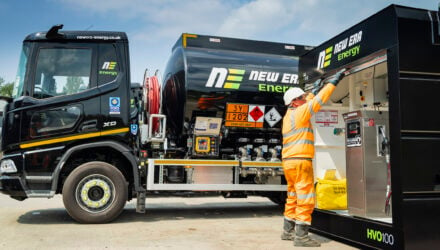Vehicle Testing and Roadworthiness Policy Specialist Richard Clements, explains what is involved and why vehicles and trailers should be presented for test laden.
Testing a vehicle’s braking performance is an important road safety aspect of the annual test and periodic maintenance inspections. As part of a Heavy Goods Vehicles (HGV – motor vehicles & trailers) annual test, DVSA carries out a roller brake test according to the ISO brake testing standard (21069).
Under the ISO standard, vehicles you present for test must be fully laden, apart from a few exceptions.
 Why do vehicles need to be laden?
Why do vehicles need to be laden?
An appropriate amount of weight should be placed on the vehicle and/or trailer. This allows the Vehicle Standards Assessor to accurately carry out the test as the grip between the tyre and the rollers is at its maximum. This allows the vehicle’s wheels to keep turning for longer and avoid premature lock ups. The brake actuation pressure will also be at its most effective to determine a more meaningful assessment of the overall braking efficiency.
In most circumstances, to achieve this, vehicles must be loaded to at least 65% of their design axle weights with cargo (this doesn’t have to be the cargo you would usually carry) or loaded with ballast to achieve this. The Goods Vehicle plating and testing regulations 1988 (at regulation 8 (2) (k)) state that an examiner may refuse to accept a vehicle or trailer for test where it is not satisfactorily loaded.
Occasionally, due to the vehicle’s design this can be hard to achieve. In these cases we would accept less the 65% but no lower the 50%,
You may load the vehicle yourself or ask the Authorised Testing Facility to supply ballast for you to use. They can charge you for this service.
The load or ballast used for annual test must be safely secured on or in the vehicle. Otherwise, the test may be refused.
What if my vehicle is unladen when I bring it in for its annual test?
A small number of operators have presented vehicles for test at ATFs unladen. They have been tested as presented but the operators are taking a chance on passing with insufficient efficiency and wheel lock-ups only and may fail to meet the appropriate test standard.
To maintain road safety, vehicles presented for test must be appropriately laden for test from 1 January 2023.
 After this date, a Vehicle Standards Assessor will refuse to test a vehicle which is not appropriately laden. You will lose the test fee and will need to re-present the vehicle or trailer correctly laden and pay for a new test.
After this date, a Vehicle Standards Assessor will refuse to test a vehicle which is not appropriately laden. You will lose the test fee and will need to re-present the vehicle or trailer correctly laden and pay for a new test.
You can find guidance on loading vehicles adequately for the roller brake test on GOV.UK. This also provides guidance on vehicles which may reasonably be expected to be tested without a load such as a tri-axle semi-trailer, road sweeper or concrete mixer.
Safety is crucially important
The Traffic Commissioners (TCs) and DVSA have focussed on brake testing since the 2014 Bath tipper tragedy. All the industry bodies have supported us on this. The results are showing this effort is paying off. In 2014, 3.3% of heavy goods motor vehicles failed their annual test on service brake performance. In the last quarter of 2021, that had reduced to 1.88%.
This is a great improvement but more can still be done. TCs may consider taking action where an operator’s test history is unsatisfactory.
Roller brake tests should be carried out in the same week as your preventative maintenance inspections (PMIs). They should also be done to the same standard and procedure.
The same constraints on loading vehicles do not necessarily apply, given the flexibility in the Guide to Maintaining Roadworthiness on when a brake performance test can be carried out. They can also be done separately from the PMI check.
Author: Richard Clements
Source: Moving On






